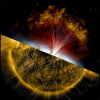 The Stellar Astrophysics research area focuses on studying stellar clusters as determiners of structure, formation, chemical evolution, dynamics and kinetics of different components of the Milky Way and the Magellanic Clouds.
The Stellar Astrophysics research area focuses on studying stellar clusters as determiners of structure, formation, chemical evolution, dynamics and kinetics of different components of the Milky Way and the Magellanic Clouds.
Main research topics/inquiries:
- Chemical evolution of the Small Magellanic Clouds across their dynamic history.
- Ensambling history of the Magellanic Clouds.
- Internal structure of stellar clusters.
- Globular clusters of the Galactic Bulge.
- Follow-up Spectroscopic follow-up of the VISCACHA (VIsible Soar photometry of star Clusters in tApii and Coxi HuguA) photometric survey.
- Relationship between [Fe/H] and variability in red giant stars in stellar clusters from the Milky Way.
Abilities/Strengths:
This team has got experience of analysing high-quality photometric and spectroscopic data of single stars and stellar populations collected by large-scale surveys and advanced telescopes.








